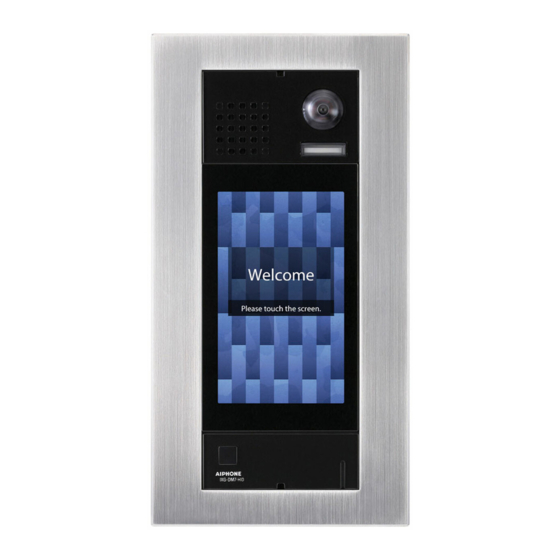
Aiphone IXG Series Commercial Quick Start Programming Manual
Ip multi-tenant video intercom
Hide thumbs
Also See for IXG Series:
- Quick start manual ,
- Operation manual (40 pages) ,
- Installation manual (28 pages)
Table of Contents
Advertisement
Quick Links
IP Multi-Tenant Video Intercom
Commercial Quick Start Programming Guide
If updating dimensions, be sure to update the GLC layer too.
Please refer to the Product Dimensions Master located here:
H:\Engineering Services\Product Dimensions Master Document\Product Dimensions Master.xlsx
ATTENTION:
This is an abbreviated programming manual addressing basic program settings for an IXG System using the
IXG Support Tool. A complete set of instructions
www.aiphone.net. In North America, visit www.aiphone.com/IXG for additional literature and media.
IXG SERIES
IXG-2C7
8-15/16"
(IXG Operation Manual / IXG Support Tool Setting Manual)
IX-DV
IX-DV
4-1/2"
1"
If updating dimensions, be sure to update the GLC layer too
Please refer to the Product Dimensions Master located her
H:\Engineering Services\Product Dimensions Master Document\Product Dimensions Master.xlsx
1-3/4"
can be found at
Advertisement
Table of Contents

Subscribe to Our Youtube Channel
Summary of Contents for Aiphone IXG Series
- Page 1 This is an abbreviated programming manual addressing basic program settings for an IXG System using the IXG Support Tool. A complete set of instructions can be found at (IXG Operation Manual / IXG Support Tool Setting Manual) www.aiphone.net. In North America, visit www.aiphone.com/IXG for additional literature and media.
-
Page 2: General Overview
The IXG Support Tool is designed to batch configure all stations simultaneously, by finding each station on the network by its MAC address. The IXG Series is designed to function on a managed network, however, the broadcast method used to find stations during the programming process may require advanced network configuration or routing to function properly in this environment. -
Page 3: Site Settings
Site Settings From the side menu, expand Site Settings. Starting from the top setting option, Site Information, configure and customize the system. Site Information Site, Installer and End User information that is set when creating a new system can be found and edited here. Building Information Name the building (or buildings) that Units and their stations will reside in. -
Page 4: Station Information
Site Settings Cont. Gateway Registration If the system contains Mobile Apps, the Gateway (IXGW-GW) is required. To add the Gateway to the system, select Enable, then optionally edit its Station Name, and review the other settings. Once configured, click Update . Gateway Selection Use the drop-down menu under Gateway Number to select the Gateway added in the previous step. -
Page 5: Advanced View
Association Settings Station Settings and Station List From the top menu, select Connection and click Association Settings. Here, stations created in the previous steps will be associated to stations found on the network. Select a station from the Station Settings List and one from the Station List below. -
Page 6: Call Settings
Call Settings Called Stations (Door/Sub Stations) To enable a call from a door station to a master station, expand Call Settings from the side menu and select Called Stations (Door/Sub Stations). Use the drop-down between a door station and a master station and select “U”. To place a “U”... -
Page 7: Upload Settings
Downloading the App Before registering the IXG Mobile App to a Unit, it will need to be downloaded to the mobile device. Search for "Aiphone IXG" in the Apple App Store for iOS devices, or Google Play Store for Android devices. Once installed, and the privacy policy... - Page 8 Mobile App Integration Cont. Upload Settings to IXG Cloud Server First, the system settings must be uploaded to the IXG Cloud Server. To do this, select App Integration from the top menu and select Upload Settings to IXG Cloud Server. From there, follow the prompts. Export App Registration QR Code as a PDF To register mobile devices to the IXG system, a QR Code is generated for each specific Unit.












Need help?
Do you have a question about the IXG Series and is the answer not in the manual?
Questions and answers